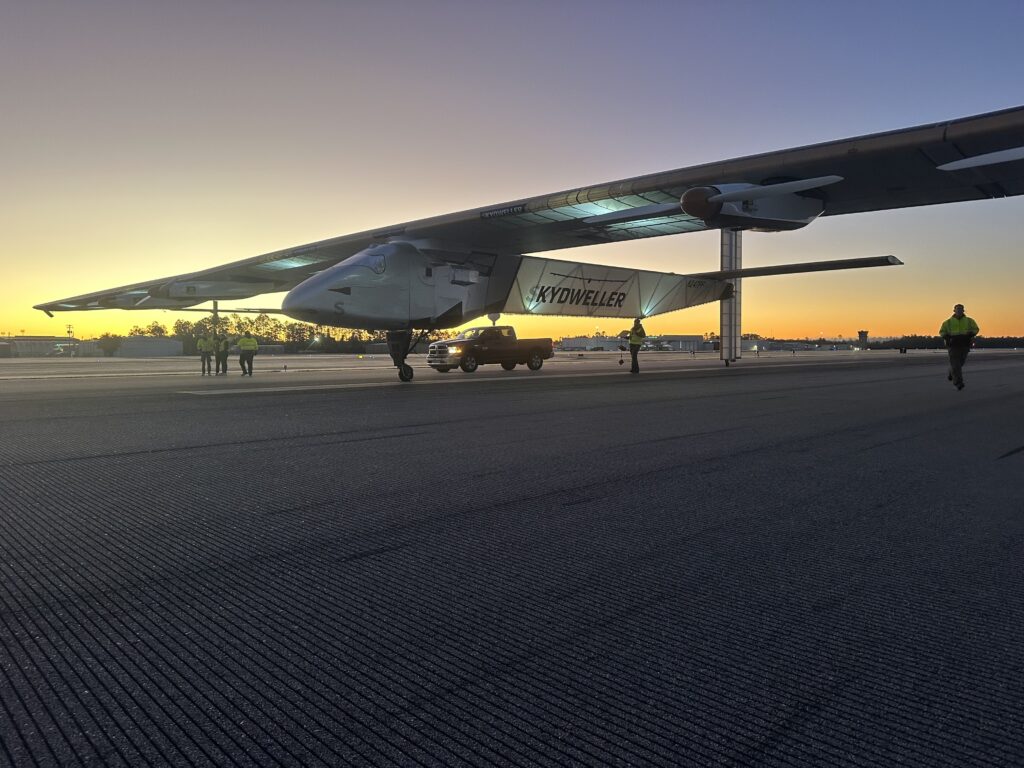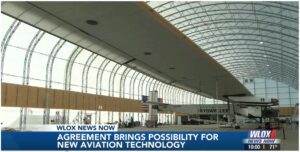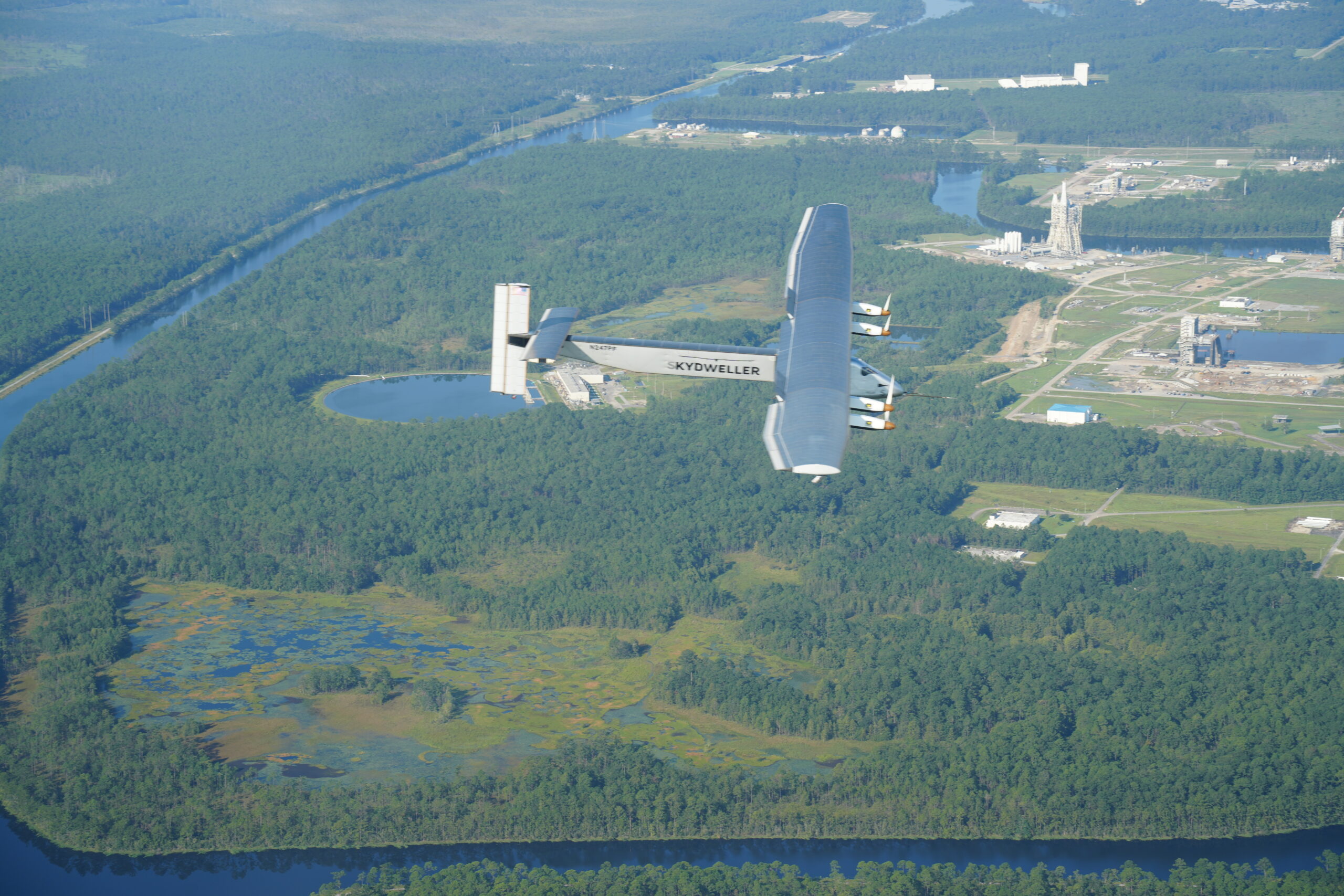
Oklahoma Firm Working Toward ‘Perpetual Flight’ – AVweb
Skydweller Aero advances autonomous solar aircraft testing for operational deployment in 2025
Skydweller Aero advances autonomous maritime patrol aircraft testing with military payloads
Skydweller Aero continues AMPA flight tests with operational military payloads | CompositesWorld
Skydweller Aero continues flight tests with operational military payloads – Air Cargo Week
Skydweller Aero continues Autonomous Maritime Patrol Aircraft (AMPA) Flight Tests – Naval News
Skydweller Aero Continues AMPA Flight Tests with Operatioanl Military Payloads
Skydweller continues tests – IOT Insider
Skydweller Aero advances flight tests for its Autonomous Maritime Patrol Aircraft – Defense Here
Solar aircraft soars with groundbreaking 22-hour autonomous flight mission. | USA Solar Cell
NASA Stennis to support unmanned aircraft testing – Machinery Market News
MS Stennis Space Center tests uncrewed aircraft
NASA Stennis expands range operations with new Skydweller Aero agreement
NASA Stennis Takes Key Step in Expanding its Range Operations Work – WXXV News 25
NASA Stennis Expands Range Operations Efforts | Mirage News
Skydweller Aero allowed use of NASA Stennis Space Center restricted airspace – Magnolia Tribune
NASA Stennis takes key step in expanding its range operations work | News | seacoastecho.com
U.S. Navy Eternal Drone Signals The Dawn Of Practical Solar Flight (forbes.com)
Solar-powered plane off Gulf Coast could spend months in air | Business News | nola.com
Skydweller Completes Autonomous Solar-Powered Flight Tests | RealClearDefense
Aviation Week features Skydweller Aero – “Solar-Powered UAS Completes 22.5 hour Flight” – Skydweller
SkyDweller Aero completes tests of ultra-long-endurance solar aircraft | News | Flight Global
Skydweller Aero Completes Successful Uncrewed Solar Flight Tests (botsanddrones.uk)
Skydweller Aero Successfully Completes “First Uncrewed Flight Test Campaign” – eVTOL Insights
Skydweller Aero: The 90-Day Solar Flight Revolution (aircomment.info)
World Military News: Skydweller Completes Autonomous Solar Powered Flight Tests
First flight: Solar-powered Skydweller — General Aviation News
Game-Changer: Solar-Powered Skydweller Drone Flies for 22.5 Hours in Breakthrough Test (msn.com)
Skydweller successfully concludes series of autonomous flights – IOT Insider
Skydweller Aero completes initial uncrewed flight test campaign – SatNews
Skydweller Aero successfully completes initial uncrewed flight test campaign – Air Cargo Week
Skydweller Aero completes autonomous flight test campaign | CompositesWorld
Skydweller Aero Completes Uncrewed Flight Testing | Aero-News Network
Skydweller completes initial flight test campaign | Revolution.aero
Skydweller Aero Successfully Completes Uncrewed Flight Test Campaign | UAS Magazine
Solar-Powered ‘Skydweller’ Drone Flies 22.5 Hours in Test (thedefensepost.com)
Skydweller’s solar UAS aces test flight campaign, hitting milestones. | USA Solar Cell
Skydweller Autonomous Solar Flight Test Completed (defencetrend.com)
News :: Airplanes :: Skydweller completes initial flight test campaign (avfoil.com)
Skydweller Aero Triumphs with Record-Setting Uncrewed Aerial Tests – UASweekly.com
Skydweller’s solar-powered UAS completes test flight campaign (aerospaceglobalnews.com)
US tests Skydweller drone with solar panels (gagadget.com)
Skydweller drone completes first uncrewed flight test campaign | Aerospace Testing International
Skydweller completes autonomous solar-powered flight tests (defence-blog.com)
Skydweller Aero Successfully Completes Uncrewed Flight Test Campaign | UAS Magazine
Skydweller Aero Successfully Completes Initial Uncrewed Flig (asdnews.com)
Solar-power drone completes flight test for U.S. military – Military Embedded Systems
U.S. has tested an eternal drone: What you need to know | News.az
A solar-powered plane flies continuously for more than 20 hours: this is Skydweller

OKLAHOMA CITY | 16 December 2024 – Skydweller Aero Inc., a global leader in Perpetual Flight® uncrewed solar aircraft (USA), continues its Autonomous Maritime Patrol Aircraft (AMPA) flight tests of the Skydweller unmanned aerial system (UAS) with operational military payloads integrated onboard.
“Skydweller is equipped with a variety of sensor systems and is conducting flight tests out of Stennis International Airport in preparation for operations during 2025,” said Dr. Robert Miller, CEO and Co-founder of Skydweller Aero. “The resilience and robust design of our aircraft allow us to operate a multi-INT sensor suite of payloads throughout the winter, and we expect to conduct multi-day demonstrations in early 2025 over operationally relevant areas.”
These flights build upon Skydweller Aero’s successful autonomous flight trials conducted in late summer and fall 2024. Despite the challenging Gulf Coast weather—including two hurricanes—the company completed six flights between August 22 and September 22, four of which were fully autonomous. The longest missions lasted 16 and 22.5 hours respectively, demonstrating the aircraft’s operational effectiveness over land and offshore environments, as well as at altitudes of up to 33,000 feet.
“The aircraft maintained an impressive operational tempo, flying on average one mission every five days,” Dr. Miller added. “This performance showcases the reliability and ease of maintenance of our platform.”
Operating amid peak Atlantic hurricane season, Skydweller’s Flight Operations, Weather Scientists, and Ground Support teams worked together to fine-tune the aircraft’s autonomous capabilities, ensuring a rapid response to shifting weather conditions.
“Flying in close proximity to Mississippi thunderstorms allowed us to test and enhance our weather-avoidance systems. Skydweller’s ability to navigate these conditions highlights its operational value, especially in tropical regions during hurricane and typhoon seasons.” explained Dr. Miller. “This ability to navigate around dynamic weather patterns is vital for missions that require flight in challenging environments; avoiding sudden thunderstorms is similar to evading air defenses.”
“And unlike many other uncrewed aircraft, we are not limited to clear-sky operations in controlled environments, like the Arizona or New Mexico deserts, but will operate in operationally relevant theaters,” he added.
The Skydweller is distinguished by its durable design, exceptional payload capacity and substantial power output for mission-critical systems, offering kilowatts of continuous power for payloads. This unique combination enables Skydweller to undertake extreme duration missions across diverse and challenging environmental conditions.
“Skydweller’s capabilities have been consistently validated through rigorous flight testing, achieving significant milestones without any safety incidents,” said Barry Matsumori, President & COO of Skydweller Aero. “By leveraging our team’s deep expertise in aeroelastics, flight control systems, mission systems, and autonomy, we are developing what we believe to be the world’s first operationally viable perpetual flight platform—designed to serve the needs of both government and commercial markets.”
About Skydweller Aero Inc.
Skydweller Aero Inc. is a pioneering transatlantic aerospace company developing a fleet of the world’s largest solar powered uncrewed aircraft capable of performing extreme endurance flights with heavy, powerful payloads. Skydweller autonomous all carbon fiber aircraft have a wingspan greater than a 747 and weigh about the same as a Ford F-150. Skydweller’s uncrewed aircraft will be used for ultra-long duration missions such as providing exclusive economic zone (EEZ) enforcement, monitoring naval activity, and detecting drug smugglers and pirates at sea. Skydwellers accomplish these missions with zero carbon footprint. Skydweller Aero Inc., backed by venture and private capital, has World and US headquarters in Oklahoma City and European offices headquartered in Spain. http://www.skydweller.aero
FOX’s CyberGuy Features Skydweller Aero
Solar-powered aircraft achieves groundbreaking 22-hour autonomous flight
How perpetual flights could soon be reality
Imagine an aircraft that can stay airborne for weeks, even months, without refueling. This isn’t futuristic fantasy.
Skydweller Aero is working toward turning this vision into reality with its innovative solar-powered plane.
As the world’s largest unmanned solar-powered aircraft, Skydweller is pushing the boundaries of what’s possible in aviation.
The Skydweller advantage
What sets Skydweller apart from its predecessors? Its foundation is built on the Solar Impulse, the first solar-powered aircraft to circumnavigate the globe. This heritage provides Skydweller with a robust design capable of carrying substantial payloads. With a wingspan of 236 feet (larger than a 747) and weighing just 5,620 pounds (about the same weight as a Ford F150), the Skydweller can carry up to 800 pounds of payload.
A milestone achievement
Skydweller Aero recently achieved a significant milestone by completing a series of uncrewed autonomous flight tests. The longest of these flights lasted an impressive 22½ hours, launched from the company’s facility at Stennis International Airport in Kiln, Mississippi. This achievement demonstrates the feasibility of remaining airborne for extended periods using solar energy and batteries.
Kurt’s key takeaways
As the world’s largest unmanned solar aircraft, Skydweller Aero is revolutionizing aviation and opening up exciting new possibilities. From enhancing maritime patrols to serving as airborne communication platforms, the potential applications are vast.
Watch / read FOX’s CyberGuy Feature Skydweller Aero:
Link to video – https://www.foxnews.com/video/6364663907112
Link to article – Solar-powered aircraft achieves groundbreaking 22-hour autonomous flight | Fox News Video

Skydweller Aero Can Help Defend Against Chinese Fishing Fleet Encroachments
The Wall Street Journal has revealed how Chinese fishing fleets are impacting the fishing industry of Peru and other vulnerable countries globally, threatening both local communities and national economies.
For developing nations, maritime domain awareness is vital for protecting sovereignty, sustaining economies, and supporting long-term environmental health.
Effective surveillance and response capabilities are crucial in guarding against overfishing and illegal activities within under-regulated exclusive economic zones.
Skydweller Aero is committed to advancing persistent surveillance solutions that enhance real-time situational awareness across vast maritime territories. For enforcement to be effective, agencies need photos of fishing boats with nets in the water, and the ability to identify those vessels.
Agencies need Skydweller.
Our innovations in solar-powered, autonomous aircraft empower countries to protect their resources and secure their maritime interests.
China’s Massive Fishing Fleet Overwhelms Locals in ‘David and Goliath’ Battle – WSJ

Skydweller Aero Incorporated has come to an agreement with NASA Stennis Space Center to use restricted airspace for test flights.
“It was a challenge because they had a lot of different scenarios based on their requirements,” said Jason Peterson, Range Operations Manager at NASA Stennis Space Center. “They pushed the envelope so to speak, but we were able to overcome that with our team.”
With this access, Skydweller will be able to perform test flights in a controlled airspace with limited obstacles, allowing for less hiccups as they work on developments.
“This is developing technology that’s going to connect the unconnected from a digital perspective, and make the world a safer, more connected place,” said Robert Miller, CEO of Skydweller.
The aircraft Skydweller flies is different from your typical plane. This plane is manned by a remote pilot and powered by solar power, allowing for less carbon emissions and extended flight times.
“Conventional unmanned aircrafts fly for 40-80 hours tops,‘ said Miller. ”We’re talking about flying for weeks, months, so hundreds and thousands of hours we’d be in the air.”
With this agreement, the expected speed for findings should increase greatly, allowing for the newest breakthroughs in aviation technology to be found here in South Mississippi.
“This is technology that people in Silicon Valley failed at that were succeeding in in Mississippi and Oklahoma,” said Miller.
Aviation agreement to bring new tech breakthroughs to the Gulf Coast

NASA’s Stennis Space Center and Skydweller Aero enter agreement for company to operate its solar-powered autonomous aircraft in the site’s restricted airspace, a key step towards Stennis achieving a strategic goal.
NASA’s Stennis Space Center near Bay St. Louis, Mississippi, has entered into an agreement with Skydweller Aero Inc. for the company to operate its solar-powered autonomous aircraft in the site’s restricted airspace, a key step towards achieving a strategic center goal.
The Reimbursable Space Act agreement marks the first between NASA Stennis and a commercial company to utilize the south Mississippi center’s unique capabilities to support testing and operation of uncrewed systems.
“There are few locations like NASA Stennis that offer a secure location, restricted airspace and the infrastructure to support testing and operation of various uncrewed systems,” said NASA Stennis Director John Bailey. “Range operations is a critical area of focus as we adapt to the changing aerospace and technology landscape to grow into the future.”
NASA Stennis and Skydweller Aero finalized the agreement in late August, paving the way for the company to begin area test flights of its autonomous, uncrewed solar-powered aircraft, which features a wingspan greater than a 747 jetliner and is designed for long-duration flights.
“Access to the restricted airspace above NASA Stennis has been tremendously helpful to our uncrewed, autonomous flight operations,” said Barry Matsumori, president and chief operating officer of Skydweller Aero. “The opportunity to use the controlled environment above Stennis helps accelerate our efforts, allowing us to transition the aircraft in and out of civil airspace, while demonstrating its reliability and unblemished safety record to the FAA.”
The agreement provides the company Federal Aviation Administration (FAA) authorization for future test flights in designated areas of the NASA Stennis buffer zone. It also represents a key step in the center’s effort to grow its range operations presence.
NASA Stennis Takes Key Step in Expanding its Range Operations Work – NASA
Skydweller over NASA Stennis Space Center

Share the joy and triumph of our recently completed flight test campaign by watching this Skydweller Aero video, available here
Social Media Influencer “Papa Mississippi” is a proud Mississippian.
He is so happy that Skydweller Aero flies from Stennis International Airport in Kiln that he made this video.
Enjoy!

The Oklahoma-headquartered firm on 30 September said the Skydweller UAS successfully conducted a series of autonomous long-duration flights in recent weeks, including one sortie lasting 22h 30min and another spanning 16h.
SkyDweller Aero completes tests of ultra-long-endurance solar aircraft | News | Flight Global

The complete article can be accessed here (subscription required): Skydweller Solar-Powered UAS Completes 22.5-hr. Flight | Aviation Week Network
Excerpted from Aviation Week:
…the Sept. 22 mission demonstrated the feasibility of staying airborne for weeks to months on solar power and batteries. “The data gathered validates our model for multiday flights,” co-founder and CEO Robert Miller says.
The flights also showed the aircraft’s ability to fly in operationally relevant weather. “We’re not flying in Yuma in July. We’re flying over the Gulf Coast in hurricane season,” he says, referring to previous record-setting solar-powered UAS flights conducted over Yuma Proving Ground in Arizona.
Autonomous flights with no pilot on board began with a 3-hr. 10-min. mission on. Sept 14. A 16-hr. 11-min. flight followed on Sept 19-20 and led up to the 22-hr. 22-min autonomous flight on Sept 21-22. The flight was cut short because of the risk of high winds from the approaching Hurricane Helene.
“We got plenty of data from the 16-hr. and 22.5-hr. flights that shows we can do perpetual flight,” Miller says. Another reason for truncating the final mission was the aircraft is flying on new, high-performance batteries, leading to concerns about performance at low voltage after powering the aircraft through the night. But the flight showed “we have more margin than we thought we had,” he says.
The longer flights also demonstrated the aircraft ’s redundancy and turnaround between missions. A circuit breaker failed early on the 16-hr. flight, but the system redundancy handled the failure correctly and the aircraft flew on for another 13 hr., Miller says. The breaker was replaced aft er landing and a day later the aircraft was launched again. “We put a new one in and it flew for 22.5 hours,” he says.
The flights also showed the aircraft ’s ability to operate in the vicinity of weather, as the 16-hr. flight was conducted with developing thunderstorms in the area. “This shows we can fly in an operationally relevant environment,” Miller says. This supports the Skydweller UAS’ use for long-duration missions from the U.S. over the Caribbean and West Africa where the Pentagon does not have forward bases.
Because of its size…the Skydweller UAS can carry heavier payloads than other solar-powered and most medium-altitude uncrewed aircraft. The aircraft is flying with two line-of-sight data links and three satellite communications systems—Iridium, Inmarsat and Skylight—with a fourth to be added. “That’s a lot of capacity,” he says.
